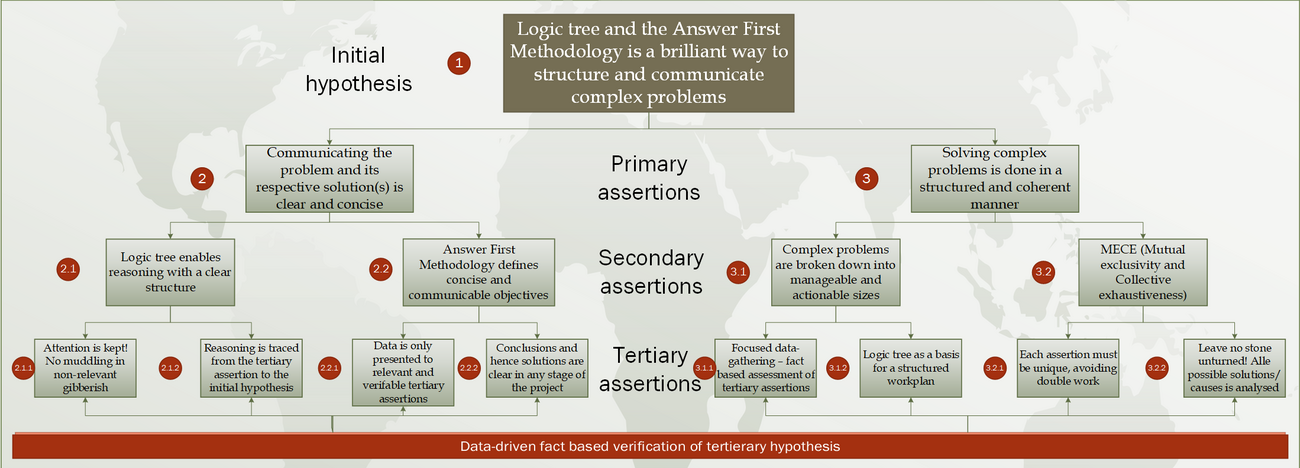Logic tree and the Answer First Methodology
(→Big Idea) |
(→Big Idea) |
||
| Line 19: | Line 19: | ||
---- | ---- | ||
''The elevator test'' [McKinsey way] states that a problem solver post-analysis should strive to be able to communicate a complex problem and its’ solutions over the course of an elevator ride. For you ‘stair people’ out there that is approximately 30 seconds. ‘Why?’ You may ask. The reason is two-fold: 1. For you to be able to boil a complex problem and its’ solutions down to 30 seconds requires a thorough comprehension of the essentialities within each of them. 2. The problem owner, be it manager or executive, whom are either responsible for change or can give you the mandate to implement a change simply does not have time to engage in the problem like you have. It is your job to present to him/her the essentialities of your findings [Mckinsey]. | ''The elevator test'' [McKinsey way] states that a problem solver post-analysis should strive to be able to communicate a complex problem and its’ solutions over the course of an elevator ride. For you ‘stair people’ out there that is approximately 30 seconds. ‘Why?’ You may ask. The reason is two-fold: 1. For you to be able to boil a complex problem and its’ solutions down to 30 seconds requires a thorough comprehension of the essentialities within each of them. 2. The problem owner, be it manager or executive, whom are either responsible for change or can give you the mandate to implement a change simply does not have time to engage in the problem like you have. It is your job to present to him/her the essentialities of your findings [Mckinsey]. | ||
| + | |||
| + | <span style="color: red; text-decoration;">3</span> | ||
= Application = | = Application = | ||
Revision as of 08:38, 18 February 2021
Contents |
Abstract
Problem solving in a company is difficult: Not only do you first have to identify a problem, but the company may also be so deeply entrenched in the way that they are doing things that they cannot possibly consider doing it differently. Developed by highly respected consultancy firms, The answer first methodology is a proven way of structuring a problem and the subsequent project activities in a way that is communicable, coherent, and thorough. By defining a problem as a primary assertion and working out from that, it is broken down into smaller, test-able fragments. What follows is a testing of the sub-assertions and whether proposed solutions will have an effect on the sub-assertion and through that the primary assertion. This breakdown enables a methodical, solution oriented and coherent project work where the main problem is always in focus. Framing the project around a primary assertion also creates a narrative that presentable and easy to follow for stakeholders. This article will briefly explain the birth of this methodology. Subsequently it will explain how it fits into the contemporary bigger picture of business management. What follows will be a crash-course in working with projects using the answer first methodology. This article will also highlight the pitfalls one can encounter when using this methodology as well as provide a general example throughout the presentation of the tool.
Introduction
Big Idea
1
What better way to further communicate and exemplify that the Logic tree and the Answer First Methodology is a brilliant way to structure and communicate complex problems, than use the methodology as a framework to explain itself! If this methodology is successful in communicating itself, it will no doubt be a useful tool to managers or prospective engineers too.
What comes first is the Initial hypothesis. This hypothesis not only lays a foundation for further exploration within the problem owners’ area of solution, but also provides a solution to the problem from the get-go. That's right - you answer the problem before you have even done any analysis or research!
2
The elevator test [McKinsey way] states that a problem solver post-analysis should strive to be able to communicate a complex problem and its’ solutions over the course of an elevator ride. For you ‘stair people’ out there that is approximately 30 seconds. ‘Why?’ You may ask. The reason is two-fold: 1. For you to be able to boil a complex problem and its’ solutions down to 30 seconds requires a thorough comprehension of the essentialities within each of them. 2. The problem owner, be it manager or executive, whom are either responsible for change or can give you the mandate to implement a change simply does not have time to engage in the problem like you have. It is your job to present to him/her the essentialities of your findings [Mckinsey].
3
Application
Text
Limitations
Text
